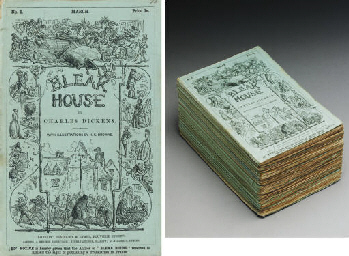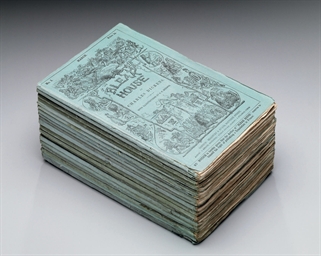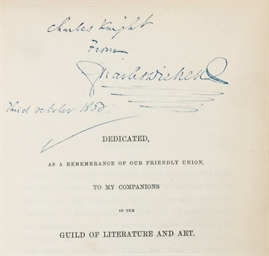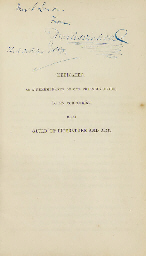DICKENS, Charles (1812-1870). Bleak House . London: Virtue and Co. for Chapman and Hall, 1866. 8° (190 x 125mm). Half-title. Stereotype frontispiece by and after Hablot K. Browne. (Occasional spotting and ink- or fingermarking.) Original green cloth gilt, the covers blocked in blind with floral borders surrounding central cartouches lettered 'THE WORKS OF CHARLES DICKENS CHEAP EDITIONS' [ sic ], the spine decorated and lettered in gilt (extremities lightly rubbed, spine darkened, hinges split, some quires pulled), later slipcase. Provenance : Charles Dickens (running title 'BLEAK HOUSE' struck through on the rectos of all leaves but B1 (the first page of the text) and 2K6, and alternative titles supplied in the author's hand) -- Henry Morley (1822-1894, cf. A. de Suzannet Catalogue des manuscripts, livres imprimés et lettre autographes composant la bibliothèque de La Petite Chardière Lausanne (Lausanne: [1948-9], unpublished typescript ed. M. Slater, ms. gloss in Slater's hand to 277B, 'Des bibliothèques Henry Morley et Forster Morley') -- Comte Alain de Suzannet (1882-1950, bookplate on upper pastedown; his sale Sotheby's London, 22-23 November 1971, lot 111, to:) -- Hoffmann & Freeman (named buyers). 1866 reprint of the 1858 'Cheap' edition. RUNNING TITLES SUPPLIED IN DICKENS'S HAND, PROVIDING 'A COMBINATION OF STRAIGHTFORWARD SUMMARY, IRONICAL COMMENTARY, AND MORAL JUDGEMENT' (Ford and Monod p.799), for use in the 'Charles Dickens Edition'. During the years that followed a railway accident at Staplehurst in June 1865 which both Dickens and Ellen Ternan were involved in, the writer was increasingly troubled by a sense of his own mortality. This was reinforced by a series of deaths amongst his circle of friends and colleagues, and meant that 'almost every activity in which he was engaged after June 1865 had the aspect of a winding-up, a finale' (R.L. Patten Dickens and his Publishers (Oxford: 1978), p.310). This expressed itself in part in a desire to ensure that both his beneficiaries and reputation would be well served by his monetary and literary legacies after his death -- as Dickens recorded in his diary after meeting William Wordsworth junior, 'Wordsworth (fils) decidedly lumpish . Copyrights need to be hereditary, for genius isn't' (entry for 5 February 1839, M. House, G. Storey and K. Tillotsons (ed.) The Letters of Charles Dickens (Oxford: 1965-2002), I, p.639). Therefore, he determined to revise his works for an edition to be published under the title of 'The Charles Dickens Edition', which was the last edition of his works to be published during his lifetime and under his supervision, and was issued in 21 volumes by Chapman and Hall between 1867 and 1875; as Ford and Monod state, this edition 'is currently regarded as providing the authoratative text [...] no edition of Bleak House later than the Charles Dickens was controlled by the author; none, therefore, has the slightest textual relevance' (p.807). Although Dickens does not seem to have made amendments to the text of Bleak House , a footnote was added to the preface (citing an additional case of spontaneous combustion to add to those noted in previous editions), and in place of the running-title 'Bleak House' on all pages, the author has marked up the present copy for the printer with running-titles to be added to the recto of each leaf (with the exception noted above). This copy of the work has 516 pages (giving 257 pages for the running titles, of which Dickens provided 256); however, when the 'Charles Dickens Edition' was typeset, it ran to 540 pages, requiring 269 running-titles. Of the 256 in this copy, 203 were used in the published work, 2 cancelled, 51 altered in whole or part, and 15 new ones added (cf. Ford and Monod pp.799-803 for a comprehensive analysis). According to Slater's manuscript note in the typescript catalogue of the Comte de Suzannet's collection, this copy of Bleak House passed from Dickens to Henry Morley presumably before Dicken
DICKENS, Charles (1812-1870). Bleak House . London: Virtue and Co. for Chapman and Hall, 1866. 8° (190 x 125mm). Half-title. Stereotype frontispiece by and after Hablot K. Browne. (Occasional spotting and ink- or fingermarking.) Original green cloth gilt, the covers blocked in blind with floral borders surrounding central cartouches lettered 'THE WORKS OF CHARLES DICKENS CHEAP EDITIONS' [ sic ], the spine decorated and lettered in gilt (extremities lightly rubbed, spine darkened, hinges split, some quires pulled), later slipcase. Provenance : Charles Dickens (running title 'BLEAK HOUSE' struck through on the rectos of all leaves but B1 (the first page of the text) and 2K6, and alternative titles supplied in the author's hand) -- Henry Morley (1822-1894, cf. A. de Suzannet Catalogue des manuscripts, livres imprimés et lettre autographes composant la bibliothèque de La Petite Chardière Lausanne (Lausanne: [1948-9], unpublished typescript ed. M. Slater, ms. gloss in Slater's hand to 277B, 'Des bibliothèques Henry Morley et Forster Morley') -- Comte Alain de Suzannet (1882-1950, bookplate on upper pastedown; his sale Sotheby's London, 22-23 November 1971, lot 111, to:) -- Hoffmann & Freeman (named buyers). 1866 reprint of the 1858 'Cheap' edition. RUNNING TITLES SUPPLIED IN DICKENS'S HAND, PROVIDING 'A COMBINATION OF STRAIGHTFORWARD SUMMARY, IRONICAL COMMENTARY, AND MORAL JUDGEMENT' (Ford and Monod p.799), for use in the 'Charles Dickens Edition'. During the years that followed a railway accident at Staplehurst in June 1865 which both Dickens and Ellen Ternan were involved in, the writer was increasingly troubled by a sense of his own mortality. This was reinforced by a series of deaths amongst his circle of friends and colleagues, and meant that 'almost every activity in which he was engaged after June 1865 had the aspect of a winding-up, a finale' (R.L. Patten Dickens and his Publishers (Oxford: 1978), p.310). This expressed itself in part in a desire to ensure that both his beneficiaries and reputation would be well served by his monetary and literary legacies after his death -- as Dickens recorded in his diary after meeting William Wordsworth junior, 'Wordsworth (fils) decidedly lumpish . Copyrights need to be hereditary, for genius isn't' (entry for 5 February 1839, M. House, G. Storey and K. Tillotsons (ed.) The Letters of Charles Dickens (Oxford: 1965-2002), I, p.639). Therefore, he determined to revise his works for an edition to be published under the title of 'The Charles Dickens Edition', which was the last edition of his works to be published during his lifetime and under his supervision, and was issued in 21 volumes by Chapman and Hall between 1867 and 1875; as Ford and Monod state, this edition 'is currently regarded as providing the authoratative text [...] no edition of Bleak House later than the Charles Dickens was controlled by the author; none, therefore, has the slightest textual relevance' (p.807). Although Dickens does not seem to have made amendments to the text of Bleak House , a footnote was added to the preface (citing an additional case of spontaneous combustion to add to those noted in previous editions), and in place of the running-title 'Bleak House' on all pages, the author has marked up the present copy for the printer with running-titles to be added to the recto of each leaf (with the exception noted above). This copy of the work has 516 pages (giving 257 pages for the running titles, of which Dickens provided 256); however, when the 'Charles Dickens Edition' was typeset, it ran to 540 pages, requiring 269 running-titles. Of the 256 in this copy, 203 were used in the published work, 2 cancelled, 51 altered in whole or part, and 15 new ones added (cf. Ford and Monod pp.799-803 for a comprehensive analysis). According to Slater's manuscript note in the typescript catalogue of the Comte de Suzannet's collection, this copy of Bleak House passed from Dickens to Henry Morley presumably before Dicken















Try LotSearch and its premium features for 7 days - without any costs!
Be notified automatically about new items in upcoming auctions.
Create an alert